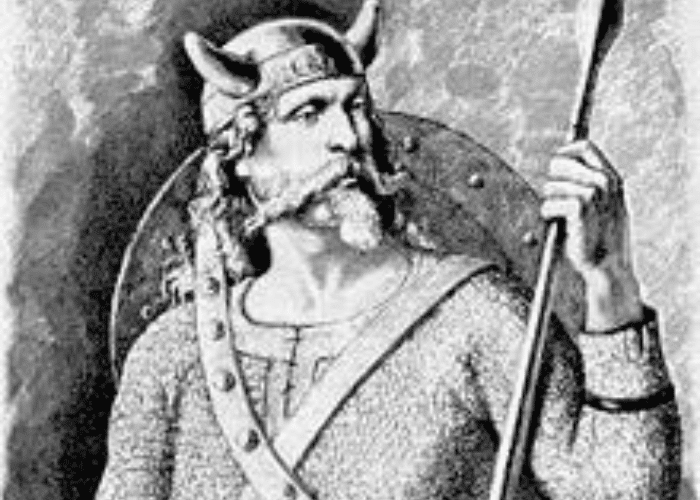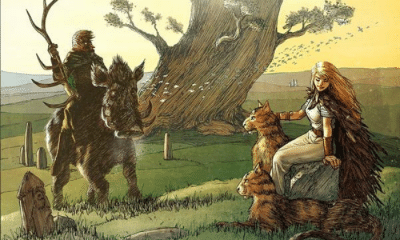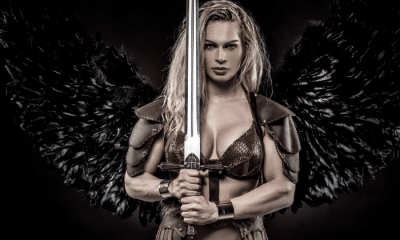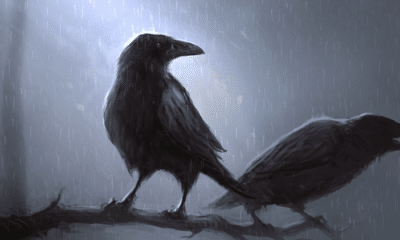
Norse
Who Was Tyr in Norse Mythology?
Who Was Tyr in Norse Mythology?
Tyr was a Norse god of battle, law, and justice. If you aren’t familiar with his myths, however, there may be a good reason!
In the Norse pantheon, virtually all the Aesir gods were in some way linked to the concept of war. Thor embodied strength, Odin was a leader, and Heimdall was a watchman.
Among all these gods of war, however, Tyr was named as the greatest. He was the bravest and most valiant god and oversaw laws and oaths.
It would seem obvious that the most courageous god would be at the forefront of Viking Age mythology, but Tyr seems remarkable in his absence.
The most well-known story of Tyr is not of his feats in battle, but of how he lost the ability to fight as well as he should. The Norse god of war was courageous enough to lose a limb in order to protect his people.
Historians believe that there may have been much more to Tyr’s story, however. From the meaning of his name to his greatest enemy, Norse mythology shows that Tyr may have once been far more powerful than he seemed.
The Ancient Origins of Tyr
While there are few surviving myths that feature Tyr, historians are nearly certain that he was one of the oldest and most prominent of the Norse gods.
One of the greatest pieces of evidence for this is the god’s name itself. Although simple, Tyr’s name contains a wealth of information about the god’s origins.
Tyr stems from the Proto-Germanic deity *Tiwaz, which in turn came from the Proto-Indo-European *Dyeus. Ancient origins, however, are not unusual among gods.
The connection to *Dyeus, however, shows that Tyr was an important god. That name is the root for those of the most powerful deities in European religions.
The Greek king of the gods, Zeus, derived his name from this ancient root. The Irish Dagda and Latin Diana share this root.
Many general terms for “god” also come from *Dyeus. These include the Latin word deus, Sanskrit devá, Irish dhe, and the English deity.
In fact, Tyr’s own name was also a generic term for divinity. The word týr referred to a god in general, while asa or van named a member of the Aesir or Vanir specifically.
Names derived from *Dyeus generally belonged to the most ancient and powerful gods. Tyr, however, was a relatively minor god of the Aesir.
Historians believe, however, that this may not have always been the case.
Mars of the Thing
Tyr’s place in Norse mythology can be clearly seen in an unexpected place. One of the best ways to understand Tyr is by looking at the way the Romans saw him.
When the Romans encountered another culture, they typically compared that culture’s gods to their own. They believed that the Germanic people and other cultures worshiped the gods of the Roman pantheon under different names.
To understand foreign religions, the Romans looked for similarities to the Olympians. They looked at commonalities in function, powers, and temperament rather than hierarchy or family relationships.
Among the Germanic gods, for example, the Romans sometimes equated Thor with Jupiter. While Odin had a more similar position, Thor and Jupiter were both thunder gods.
Tyr was called Mars by the Romans. Among the many Norse gods associated with warfare, Tyr was singled out as the one most similar to the Latin god of war.
The Romans often called Tyr by a very specific name, however. He was not just Mars, but Mars Thingsus.
The thing was a governing assembly in Norse and Germanic culture. Free people met to settle disputes, elect leaders, and hold law courts.
By associating Tyr with the thing, the Romans made it clear that he was seen as a god of law and justice rather than a more blood-thirsty war god.
Mars was sometimes seen the same way. The god of war was also a god of peace because he used military might to keep threats far away from the common people.
The Latin name Mars of the Thing made it clear that Tyr presided over a specific aspect of war. While Thor was a god of physical might, Tyr represented war as a legal force.
Norse writings also make this clear. Tyr was often cited as the god who witnessed oaths and judged disputes in addition to being a valiant fighter.
One-Handed Tyr
Only two myths survive that include Tyr as a central figure, one of which is missing significant passages. The most well-known and well-preserved legend of Tyr tells the story of how he lost his hand.
The Prose Edda recounts the story in its entirety, but it is mentioned in other works as well. This proves that it was a well-known story and not, as some other passages of the Prose Edda are thought to be, a product of an individual author’s imagination.
According to legend, the trickster deity Loki fathered three monstrous children with a giantess called Angrboða. The gods knew that Loki’s children would be their foes at Ragnarök.
They did not kill the monsters outright, though. Instead, so as to not violate the sanctity of Asgard, they banished them.
The serpent Jömundandr was thrown into the sea. He soon grew so large that he completely encircled Midgard.
Hel, who was equal parts beautiful young woman and rotting corpse, was sent to Niflheim. She became the queen of the dead there.
The gods had another plan for the wolf Fenrir, however. They hoped they could avert Ragnarök by raising him to be their ally.
They took Fenrir to Asgard and attempted to train him to trust them. As he grew larger, however, the gods and goddesses became more frightened of them.
Only Tyr was brave enough to approach the rapidly-growing wolf. Each day, he brought Fenrir meat and attempted to earn his friendship.
The gods soon became convinced, however, that it would be impossible to control Fenrir. Each day he grew larger and stronger until they decided that he would have to be bound.
They made a strong fetter to hold him, but knew they would not be able to force him into it. Instead, they appealed to Fenrir’s pride and claimed that they wanted him to try it on as a test of his strength.
Fenrir allowed the chains to be placed on him as a challenge. To the gods’ horror, he easily snapped the bonds.
They tried again, making a chain twice as strong as the first. Once again, Fenrir broke it with a single flex of his muscles.
Knowing that they had reached the limits of their own crafting ablities, the Aesir went to the dwarves. They created a magical binding that was as thin and flexible as a ribbon, but they assured the gods that it would hold any monster.
This seemingly weak string made Fenrir suspicious, however. He also claimed that breaking such a flimsy thing would not win him the fame that snapping great chains would.
The wolf answered: If you get me bound so fast that I am not able to loose myself again, you will skulk away, and it will be long before I get any help from you, wherefore I am loth to let this band be laid on me; but in order that you may not accuse me of cowardice, let some one of you lay his hand in my mouth as a pledge that this is done without deceit. The one asa [god] looked at the other, and thought there now was a choice of two evils, and no one would offer his hand, before Tyr held out his right hand and laid it in the wolf’s mouth. But when the wolf now began to spurn against it the band grew stiffer, and the more he strained the tighter it got. They all laughed except Tyr; he lost his hand.
-Snorri Sturluson, The Prose Edda (trans. Anderson)
Tyr had been the only god brave enough to feed Fenrir, and he became the only one brave enough to bind him. Although he knew he would lose his hand, Tyr made the sacrifice for the greater good of the Aesir.
His missing hand became Tyr’s most defining attribute. In art and literature, he is shown with his right hand missing as a visible sign of his courage and dedication.
Kennings
Old Norse poetry made use of a figure of speech called a kenning.
Kennings used elaborate, often circuitous language to describe a simple idea. Kennings not only made the language of poetry more beautiful, they also showcased the writer’s wit and knowledge.
Snorri Sturluson, the 13th-century writer of the Prose Edda, listed some of the kennings that were used to describe Tyr. These included:
- The One-Handed God
- Odin’s Son
- God of Battles
- Fosterer of the Wolf
- Feeder of the Wolf
Translation sometimes makes it difficult to interpret the kennings. “Fosterer of the Wolf” and “Feeder of the Wolf,” were not given as separate names by Sturluson, but are the result of two translations in English that have slightly different meanings.
Of the kennings given for Tyr, most in some way reference the story of Fenrir’s binding. Feeder of the Wolf, for example, referred either to the fact that only Tyr was brave enough to go near Fenrir or to the fact that the wolf eventually ate Tyr’s flesh, making him the One-Handed God.
The God of Battles references Tyr’s association with war. While stories do not survive, other than the tale of Ragnarök, which show Tyr in this context, he was often said to be a brave and skilled fighter.
Of Snorri Sturluson’s kennings, Odin’s Son is possibly the most interesting to historians.
In the Poetic Edda, Tyr’s father is the giant Hymir. Sturluson, however, says that he is Odin’s Son and thus the brother of Thor and Baldr.
Norse myths rarely detail the family relationships of the gods, so their connections are sometimes unknown. In the case of Tyr, two separate lineages are given.
Most historians side with the more complete and well-known account that Tyr is Odin’s son. This would give him a more prominent place among the Aesir, and presumably among their human worshippers as well, than if he were the son of a little-known giant.
This power was only tenuous, however.
Tyr’s Fall From Power
Tyr’s name and dominion over war and law make it seem likely that he was a major god of the pantheon. They give him a great deal in common with powerful gods in other cultures like Zeus or Indra.
Historians largely believe that this may have once been the case. They think that Tyr was once a prominent god in the early Germanic pantheon, if not the chief deity.
Over time, they believe, Tyr became less prominent. More war-like gods like Thor and Odin came to the forefront to meet the needs and tastes of early Germanic culture.
Tyr’s diminishing power is not only a historical theory. It is also hinted at in the texts themselves.
Tyr was a warrior god, but he gave up one of his hands to bind Fenrir. Notably, it was his right hand, the one most men would use to hold a sword, that was lost.
This meant that, although Tyr’s association with battle remained, he was physically disadvantaged in a fight. His position would have been understood to be lessened because he was no longer capable of excelling in the battles that had defined him.
A play on words in the Poetic Edda also made Tyr’s weakened position clear.
After Baldr’s death, Loki arrives uninvited at a feast of the gods. They engage in a flyting, or contest of insults, in which Lokitargets every god and goddess present.
When Tyr attempts to defend Freyr against Loki’sinsults, the trickster turns on him. He tells Tyr that he “cannot be the right hand of justice” when that very hand was missing.
This implies that Tyr’s physical injury could be taken as a sign that he was no longer fit for the position he once held. A passage in the Prose Edda seems to support this, when it says that Tyr “is one-handed and is not considered a promoter of settlements between people.”
Given this evidence, it seems as though the loss of Tyr’s hand was more than just a way to demonstrate his courage and resolve. It also showed a loss of power and position.
Ultimately, the diminished god of battle would fall for the final time. Tyr was one of the gods destined to die in Ragnarök.
The End of the Gods
While the prophecy of Ragnarök was detailed, not every god’s fate would be known. Most of the prominent gods of the Aesir, however, were named.
It was said that Tyr would battle against a monstrous wolf, but it would not be Fenrir. He would fight Garm, the guardian of Hel’s realm.
Like many of the gods, Tyr would fight a battle of mutual destruction. While he would kill Garm, he would be fatally wounded as well.
The pairing, however, seems unusual to many historians.
Garm is rarely attested to in the available sources, unlike the more prominent children of Loki that fight other deities. And, as some historians have said, it seems unusual that Tyr would not fight the same wolf who took his hand.
Instead, Odin and his Einherjar warriors would all fall against the great wolf. Fenrir would eventually be killed by Víðarr, one of Odin’s younger sons.
Interpretations of both Fenrir and Tyr, however, have led some historians to surmise that this was not always the case.
In total, four great wolves appear at Ragnarök. Only one, Fenrir, is well-attested before the writing of the Prose Edda.
Some people believe that Snorri Sturluson added the other wolves to the story in his retelling. Originally, Fenrir was the only wolf that fought the gods.
If this was the case, Tyr would have fought either alongside Odin in the battle against the wolf or against another, unknown enemy.
Fenrir is the most likely choice since other gods battle enemies they had been linked to previously. Thor, for example, nearly killed Jörmungandr once before but would only succeed, and die in the process, at Ragnarök.
Because Tyr had already lost a hand to Fenrir, it seems likely that they would have faced off again.
If, as many historians assume, Tyr was once a more prominent god than Odin, it is possible that the earliest versions of the Ragnarök legend did not have him fighting alongside another god at all.
If Tyr were once the most powerful god, he would have faced the most powerful beast. It would be Odin who was not named or fought a lesser-known creature.
Even in the story of his ultimate demise, there is evidence that Tyr was once more powerful and popular than he was in the Viking Age.
The Contradictions of Tyr
Tyr was a Norse god known for his bravery and lawfulness. He was so closely associated with warfare that the Romans compared him to Mars.
His name also indicated his importance. It comes from an ancient root that is most often applied to kingly gods and in the Old Norse language could be a term for “god” itself.
Despite all this, however, Tyr is not as well-attested as many other Norse deities.
He is the central character in only one complete myth. In it, he sacrifices his hand to ensure that the dangerous wolf Fenrir, who is destined to kill Odin at Ragnarök, can be bound until that battle.
While this displayed the courage Tyr was known for, it also weakened him. Tyr lost his sword hand and, as implied by some sources, was less worthy to oversee law and justice.
Some historians believe that Tyr may have once been a much more prominent god. Odin eventually rose to prominence, but Tyr may have once been the chief god of the early Germanic pantheon.









